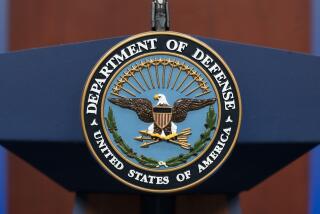U.S. Downs 2 Libyan Jets : White House Says MIGS Provoked Mediterranean Air Attack : Kadafi Threatens to Avenge ‘Terrorism’
U.S. Navy planes today shot down two Libyan MIG-23 jet fighters over the Mediterranean Sea after the American aircraft were “threatened while conducting routine operations in international airspace,” Administration officials said.
Libyan leader Moammar Kadafi condemned the action as “American terrorism” and said his nation will “meet challenge with challenge.”
Defense Secretary Frank C. Carlucci emphatically denied that the two American F-14s and their host aircraft carrier, the John F. Kennedy, were in the area with the intention of attacking a Libyan chemical weapons factory.
“The 6th Fleet operation had no connection whatsoever with Libya’s newly constructed chemical facility. These operations were conducted over 600 miles northeast” of the facility, Carlucci said at a Pentagon news briefing.
‘Matter Closed’
“We now consider this matter closed,” he said.
Libya--which before the attack had asked the Soviet Union for help in preventing a feared large-scale attack on the country--appealed for urgent meetings of the U.N. Security Council and the Tunisia-based Arab League on the incident, which Libyan officials called “premeditated.”
The Yugoslav press agency Tanjug said that Libya went on a security alert with military and civilian airfields, strategic facilities and vital installations receiving fresh reinforcements; that Libyan warplanes had been ordered to move from their bases to the Sahara for more security, and that armed guards were posted at main roads.
Kadafi’s home was transformed into a fortress with additional anti-aircraft guns set up on its roof, and batteries of French-made anti-aircraft missiles were placed on surrounding hills and parks, Tanjug said.
First Since ’86 Bombing
The air battle was the first fighting between the United States and Libya since American jets bombed Tripoli in 1986 and came amid rising tension between the two countries over Libya’s construction of the plant.
At the State Department, spokesman Charles E. Redman also said there is no link between the plant and the warplane incident. “There is absolutely no connection to any other story or concern you may have,” he said. “It may be ironic, but the two things are not related.”
The American force “posed no threat to Libya” and the fighters were operating under “normal peacetime rules of engagement,” Carlucci said, referring to the guidelines on when U.S. servicemen can open fire on forces that are thought hostile.
The commander of the F-14 patrol made the decision to fire at the Libyan aircraft “in self-defense,” and apparently shot down both planes, Carlucci said. The four crewmen of the two planes were being flown to a U.S. base at Naples, Italy, for debriefing, he said.
“At the time of the incident, both the ship and its aircraft were conducting training operations” between the Greek island of Crete and Libya, he said. “The aircraft carrier was 127 miles north of Tobruk, Libya” and the F-14s “were providing combat air patrol 50 miles south of the Kennedy, which is some 70 miles north of the northeast Libyan coast,” he said.
Carlucci said the F-14s descended from 15,000 to 4,000 feet in altitude and attempted five separate evasive maneuvers. “They changed speeds, altitude and direction,” he said.
“The Libyan aircraft continued to close in a hostile manner,” he said. “Each time, the Libyan aircraft sought to put their nose on our aircraft. They also accelerated, so the hostile intent seems to be fairly clear,” he said.
“At about 14 miles, the U.S. section leader decided that his aircraft was in jeopardy and he could wait no longer. One MIG-23 was shot down with a Sparrow missile. The second MIG was shot down by a Sidewinder missile at six miles,” he said.
Afterward, he said, “two parachutes were sighted, and a Libyan search-and-rescue helicopter was later detected headed for the area.” It was not known whether the Libyan pilots survived.
The confrontation occurred about noon local time, or 2 a.m. PST.
Sen. Sam Nunn, chairman of the Senate Armed Services Committee, said, “Indications are that Libya violated what we call the rules of engagement. . . . They maneuvered themselves into a position to be able to shoot down American planes. The rules of engagement permit self-defense in those circumstances.”
“Under those circumstances, . . . clearly it was Libya that took the provocative action,” Nunn (D-Ga.) said.
“Kadafi never learns,” said Senate Republican leader Bob Dole of Kansas. “Maybe this time he will finally get it straight. Whenever he threatens American forces, we will defend ourselves.”
More to Read
Sign up for Essential California
The most important California stories and recommendations in your inbox every morning.
You may occasionally receive promotional content from the Los Angeles Times.









